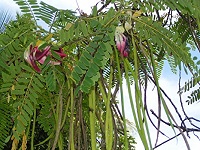Evaluation of Hepatoprotective activity of fruits of Sesbania grandiflora L. Pers against thiocetamide and ranitidine induced hepatotoxicity in rats
Keywords:
Hepatoprotective, Ranitidine, Sesbania grandiflora and ThioacetamideAbstract
The Petroleum ether extract of Sesbania grandiflora L. pers fruits showed a significant dose dependent (100mg, 200mg/kg p.o.) protective effect against thioacetamide and ranitidine induced hepatotoxicity in Wistar albino rats. The degree of protection was measured by using biochemical parameters like Serum glutamic oxaloacetic transaminase (SGOT), Serum glutamic pyruvic transaminase (SGPT), Alkaline phosphatase (ALP), Total bilirubin (BRN), Total Cholesterol (TC), Total protein and Histopathological alterations. The fruit extract completely prevented the toxic effects of Thioacetamide and Ranitidine on the above serum parameters. The petroleum ether extract of Sesbania grandiflora L. pers fruits produced significant protection.
References
. Wolf PL. Biochemical diagnosis of liver
diseases. Indian Journal of Clinical
Biochemistry 1999;14: 59–90.
. Karan M, Vasisht K, Handa SS.
Antihepatotoxic activity of Swertia
chirata on carbon tetrachloride-induced
hepatotoxicity in rats. Phytotherapy
Research 1999;13: 24–30.
. Abdullahi Bala, Phillip Murphy, Ken E
Giller. Occurrence and genetic diversity
of rhizobia nodulating Sesbania sesban
in African soils. Soil Biology &
Biochemistry 2002;34:1759–1768.
. Saravanakumar A, Vanitha S, Ganesh
M, Jayaprakash J, Ramaswamy NM.
Hypolipidemic activity of Sesbania
grandiflora in triton wr-1339 induced
hyperlipidemic rats. International
Journal of Phytomedicine 2010;2:52-
. Thiyagarajan Ramesh, Ramalingam
Mahesh, Chandrabose Sureka,
Vavamohaideen Hazeena Begum.
Cardioprotective Effects of Sesbania
grandiflora in Cigarette Smoke
exposed Rats. J Cardiovasc Pharmacol
;52(4).338-43.
. Zimmermann T, Muller A, Machnik G,
Franke H, Schubert H, Dargel R.
Biochemical and morphological studies
on production and regression of
experimental liver cirrhosis induced by
thioacetamide in Uje: WIST rats. Z.
Versuchstierkd 1987;30:165–180.
. Fontana L, Moreira E, Torres MI,
Fernandez I, Rıos A, Sanchez de
Medina Gil FA. Dietary nucleotides
correct plasma and liver microsomal
fatty acid alterations in rats with liver
cirrhosis induced by oral intake of
thioacetamide. J. Hepatol
;28:662–669.
. Kumar G, Sharmila Banu G, Vanitha
Pappa P, Sundararajan M, Rajasekara
Pandian M. Hepatoprotective activity of
Trianthema portulacastrum L. against
paracetamol and thioacetamide
intoxication in albino rats. Journal of
Ethnopharmacology 2004;92: 37–40.
. Hemieda FA, Abdel-Hady el-SK, Elnga
MA. Biochemical and histological
studies on H2-receptor antagonist
ranitidine-induced hepatotoxicity in
rats. Indian J Exp Biol 2005
Sep;43(9):782-5.
. Reitman S, Frankel S. A colorimetric
method for the determination of serum
glutamic oxaloacetic and glutamic
pyruvic transminases. American
Journal of Clinical Pathology
;28:53–56.
. Kind PRN, King EJJ. Estimation of
plasma phosphatase by determination
of hydrolyzed phenol with antipyrine.
Journal of Clinical Pathology
;7:322–330.
. Malloy HT, Evelyn KA. The
determination of bilirubin with the
photometric colorimeter. Journal of
Biological Chemistry 1937;119:481–
. Zalatkis A, Zal B, Boyyale AJ. A new
method for direct determination of
serum cholesterol. J. Lab. Clin. Med
;41:486–492.
. Woolson RF. Statistical Methods for
the Analysis of Biomedical Data. John
Wiley and Sons Inc. New York. 1987.
. Mitra SK, Venkataranganna MV,
Sundaram R, Gopumadhavan S.
Protective effect of HD-03, a herbal
formulation, against various
hepatotoxic agents in rats. Journal of
Ethnopharmacology 1998;63:181–186.
. Zimmerman HJ. Hepatotoxicity.
Appleton Century Crofts. New York,
:122.
. Wang H, Peng R, Kong R, Li Y.
Serum glutathione S-transferase
activity as an early marker of
thioacetimide-induced acute
hepatotoxicity in mice. Wei Sheng Yan
Jiu 1999; 28:179–180.
. Neal RA, Halpert J. Toxicology of
thionosulfer compounds. Annual
Review of Pharmacology and
Toxicology 1982;22:321–329.
. Ambrose AM, DeEds F, Rather LJ.
Further studies on toxicity of
thioacetamide in rats. Proceedings of
Society of Experimental and Biological
Medicine 1950;74:134–140.
. Chieli E, Malvadi G. Role of Cyt P-450
dependent and FAA containing mono
oxygenases in the bioactivation of
thioacetamide, thiobezamide and their
sulphoxides. Biochemical
Pharmacology 1985;34:395–396.
. Valois Maria, Copper Mary Anne,
Shear Neil H. An organized approach
to drug induced hepatitis. Can J Clin
Pharmacol 2003;10(2):59-62.
. Hemieda Faried AE, Abdel Hady ElSayed. Biochemical and histological
studies on H2- receptor antagonist
ranitidine-induced hepatotoxicity in
rats. Ind J Exp Bio 2005;43:782-785.
. Bhadauria M, Nirala SK, Shukla S.
Propolis protects CYP 2E1 enzymatic
activity and oxidative stress induced by
carbon tetrachloride. Molecular and
Cellular Biochemistry 2007;302:215–
. Boigk G, Stroedter L, Herbst H,
Waldschmidt J, Riecken EO, Schuppan
D. Silymarin retards collagen
accumulation in early and advanced
biliary fibrosis secondary to complete
bile duct obliteration in rats. Hepatology
;26:643–649.
. Fisher A, Le Couteur DG.
Nephrotoxicity and hepatotoxicity of
histamine H2 receptor antagonists.
Drug Saf 2004;24:39–57.
. Halparin LS. Adverse effects of
ranitidine therapy. Can. Med. Assoc. J
;130: 668– 672.



